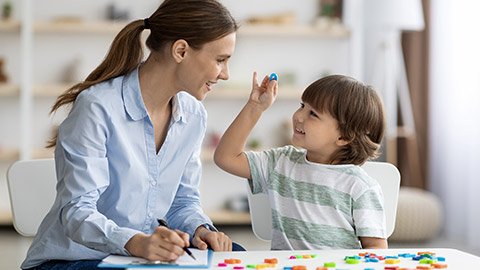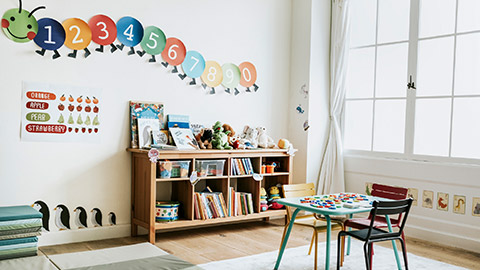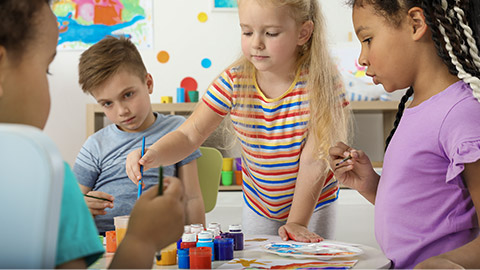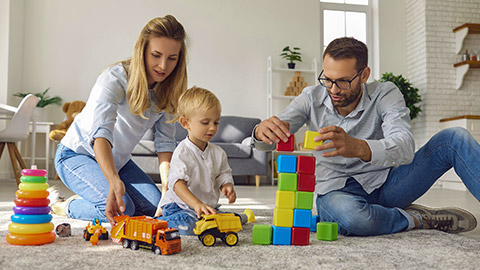Positive, respectful relationships are critical to a child’s healthy development. A child's relationships during the early years – with parents, extended family, educators, neighbours, peers and other significant people – lays the foundation for a range of critically important developmental outcomes, including self-confidence, mental health and school achievement.
By the end of this topic, you will understand:
- How can educators respond sensitively and appropriately to children’s efforts to communicate
- How to help children develop secure attachments
- How to ensure children experience safe and stimulating learning environments
- How to define ‘shared sustained thinking’ and explain how to support it among children
- How to communicate during practical tasks to help create relaxed and unhurried routines
- How to describe what interactions you should be observing when children are in groups
- How educators can encourage positive relationship building between children
- How to identify when a child might need additional support to build relationships or when to seek advice about an infant’s behaviour.
Sensitive and responsive caregiving is essential for a child’s healthy development. Sensitive and responsive care is related to long-term positive outcomes for children.
Sensitive and responsive caregiving involves a caregiver accurately interpreting a child’s cues and responding to them in an appropriate and timely way. This might involve, for example, using children’s cues to determine when they are tired, hungry, upset, frustrated or ready for a break. Consistently responding promptly to a child’s cues and signals helps children feel secure.
A sensitive and responsive caregiver is attentive and available to the child, and they have a positive attitude, demonstrating warmth, empathy and affection. They also respect the child’s autonomy and do not interfere with the child’s activities unless they determine that it is necessary. The ability to determine when a child might need additional support is part of sensitive caregiving.
Resource
For more information about responsive and respectful relationships with children, read this article on ACECQA's website.

As a result of sensitive and responsive caregiving, children develop secure attachments. A secure attachment is the healthiest form of attachment, and it is a bond between a child and caregiver. When a secure attachment exists, the child will seek out that caregiver when they need something or are upset. Having a secure attachment will boost a child’s confidence to participate in activities separate from the caregiver.
When you work with children who have secure attachments with their caregivers, you will most likely enjoy the interaction. Children who do not feel safe and secure in their environment will demonstrate behaviours such as:
- Clinging to or avoiding contact with adults
- Becoming distressed or overwhelmed by their emotions or showing a restricted range of emotions
- Not engaging with their environment
- Acting independently – as if they do not need support or reassurance from you (the educator)
The following table includes some examples of how you can help children develop secure attachments:
|
Action |
Reason for Doing the Action |
|---|---|
|
Talk to the child’s family |
When an interaction is familiar to a child, it helps them feel safe. Ask the child’s family about the child’s favourite activities and people, and find out how the family feed, change and play with the child – use this information to inform your interactions with the child. |
|
Develop positive relationships with families |
When children see their caregivers at ease with educators, it makes them feel safe about interacting with the educators. |
|
Respond consistently, predictably and calmly |
This helps children learn about expectations and boundaries – being emotionally responsive to children will help them organise their feelings. |
WATCH
The following 4-minute video explains secure attachments and the impact on children’s behaviour:
Secure attachment helps both children and adults learn positive ways to manage feelings, relationships and stressful situations. It also contributes to the development of trust, autonomy and self-esteem. In other words, adults who experienced positive attachment as infants are more likely to form more satisfying adult relationships.8

The environments where children learn should be safe, welcoming, stimulating and responsive to children’s interests.
Educators can make the most of children’s sense of curiosity and awe by creating indoor and outdoor play spaces that are interesting and engaging, and providing them with opportunities to problem solve and extend their learning and thinking. Recognise when children learn something significant and use these opportunities to strengthen learning.
Communicate with children during practical tasks in a way that helps to create relaxed and unhurried routines. Sit down with them at mealtimes and have a calm and unhurried two-way conversation with them, or engage with them during the day or session by calmly asking them about what they are doing and learning.
Children need to have opportunities to take appropriate risks. Taking appropriate risks is essential to healthy development and an important aspect of building resilience.
As an educator, you also need to be alert to and aware of potential risks and hazards in order to ensure children are safe. Keeping children safe involves active supervision. Active supervision can be achieved in a range of ways including:
- Closely observing children to provide support when it is needed
- Assessing and responding to children’s needs as well as engaging with children to promote learning opportunities
- Listening carefully to children – changes in tone or volume can assist supervision of children who are not visible to an educator
- Evaluating situations to determine potential risks and benefits
The level of supervision you provide to children will depend upon their age and ability. In most circumstances, the younger the child is, the more likely they will need supervision. Supervision is especially important when transporting children and going on excursions.
Contemporary theories and research informed by the Reggio Emilia approach recognise and value the environment as a ‘third teacher’. Behind educators and families, physical spaces hold the potential to influence what and how children learn.
Learning environments engage and foster a sense of ownership and respect when they are aesthetically pleasing, reflect the identity and culture of children and families, and encourage a connection to place. As such, the physical environment is never simply a backdrop to the curriculum; it is an integral part of the curriculum or leisure-based program. An environment with rich and built-in learning opportunities also frees educators to interact with children.9
WATCH
The following 7-minute video explains how the environment can play the role of the third teacher, according to the Reggio Emilia approach:
WATCH
The following 5-minute video shows a few practical examples of effective environments:

Shared sustained thinking is the result of two or more people working together to solve a problem or explain a concept. When a caregiver supports shared sustained thinking, they guide learning rather than dominate it.
Shared sustained thinking helps children develop the ability to think about their thinking and essentially learn how to learn (Flottman, Stuart & Tayler, 2011).
Example
Here are two (2) examples of conversations that support shared sustained thinking.
The first conversation is between an educator and a child named Simon, age four. In this example, the educator is using questions to encourage Simon to test his ideas.
Educator: If I take one of the wooden blocks out, what do you think will happen to the wooden tower?
Simon: It will fall down.
Educator: It might fall down – you could try and see what happens.
(Simon removes the wooden block, and the tower falls down.)
Educator: If I give you all these wooden blocks, could you make a studier tower? What other shapes or forms could you make?
Simon: I could make a house because it won’t have to be so tall.
(Simon builds a house using a square-pattern grid.)
Educator: Why is the house sturdier than the tower?
Simon: Because it’s not so high, so it can balance better.
This next example is of a conversation that does not support shared sustained thinking.
The conversation is between an educator and a four-year-old named Britney. Britney is trying to guess what the educator is thinking. The educator is dominating the learning and, as a result, Britney is providing one-word answers in a cautious way.
Educator: Do you know what the colour in that picture is?
(Educator points to the green tree in the picture Britney has drawn.)
Britney: Blue?
Educator: No, that’s not correct; you know this colour. Look again.
(Educator points to the green tree in the picture.)
Britney: Red?
Educator: No, it is green. The colour here is green.
You can support shared sustained thinking by having conversations with children that involve a genuine back and- forth discussion or collaborative problem-solving.
WATCH
The following 4-minute video provides some practical examples and explanations of how sustained shared thinking may look like in an education and care setting:
Check your understanding
Consider the use of open-ended questions to encourage children to reflect and extend their thinking. Imagine you are sitting next to a three-year-old who is drawing a picture on an A4 piece of paper.
What open-ended questions could you ask the child to encourage them to extend their thinking and learning? List at least four (4) questions.
For example, you could ask:
- Can you tell me about your picture?
- Why did you decide to use those colours?
- How did you decide to draw that picture?
- How did you decide what your picture will look like?

Children’s relationships with each other play a critical role in their development, especially their social and emotional development. Observing interactions between children can help you develop strategies to assist children in developing the foundational skills they need to build positive and respectful relationships with each other.
When you are observing interactions between children in groups, it is important to consider their age and stage of development.
The following table provides some examples of how children of different ages interact with each other.
|
Age Group |
How They Interact With Each Other |
|---|---|
|
0–12 months |
|
|
1–2 years |
|
|
3–5 years |
|
There are many different types of play. Some of these are more common at specific ages and stages of development:
|
Type of Play |
Age at Which It Is Observable |
Description |
|---|---|---|
|
Unoccupied Play |
Mainly observed in babies and toddlers but can be seen in all age groups. |
This form of play may not look like play at all. The child may be making seemingly random movements with no objective. However, unoccupied play is definitely a form of play and provides a foundation for future types of play. |
|
Solitary (Independent) Play |
Mainly observed in babes and toddlers but can be seen in all age groups. |
Solitary play is when a child plays alone. Children are especially likely to play independently when aged two to three years. At this age they lack the communication skills needed to play with others. |
|
Onlooker Play |
Mainly observed in toddlers but can be seen in all age groups. |
This is when a child observes other children playing but does not participate. This is a common type of play for children who are building their vocabulary. |
|
Parallel Play |
Mainly observed in toddlers but can be seen in all age groups. |
This occurs when children play side by side and they are each engaging in their own play. Parallel play is a bridge to forms of play that come at an older age. |
|
Associative Play |
Mainly observed between three and five years old. |
This is similar to parallel play in that children play separately from each other, but in this form of play they are talking and engaging with each other. For example, the children build their own towers made of wooden blocks but talk to each other about the activity. |
|
Cooperative Play |
Mainly observed between three and five years old but can be seen at times in toddlers. |
Cooperative play uses all the skills children have learned during the other stages of play. It might involve doing a puzzle, or playing a board game or a game outdoors with another child. Cooperative play is common among both older and younger preschoolers who have older siblings. |
WATCH
The following 3-and a half-minute video explains the six (6) types of play described above. The second part of the video contains a short activity to test your understanding:
What to observe
When observing group dynamics among children, some of the things you should pay attention to include:
- Stages of play (e.g. solitary, parallel, cooperative)
- Complexity of play (e.g. exploring, constructing, pretending)
- Type of behaviour being demonstrated (e.g. prosocial behaviour, aggressive or withdrawn behaviour)
- Emotions being expressed
Two (2) other important factors to observe are:
- Positive and negative actions
- Gender influences
Positive and negative actions
Within a group, children can demonstrate both positive and negative actions.
Positive actions in a group include:
- Sharing
- Taking turns
- Helpful and cooperative play
- Voluntary behaviour that benefits others
- Following rules
Negative actions in a group include:
- Aggression
- Teasing
- Bullying
- Disturbing or disrupting activities
- Arguing with others
Gender influences
Gender has been shown to influence how children interact and play with each other. For example, when conflict arises in a group, preschool-aged girls are more likely to withdraw from the situation rather than address the conflict. Boys, on the other hand, are more likely to engage in disputes when they are playing together – boys are more likely to deal with conflict in a direct way.
Gender stereotypes can also influence how children play and how they interact with others. For example, children may be reluctant to use certain toys or equipment because they view them as a ‘girl’s toy’ or a ‘boy’s toy’.
Girls may be less likely to engage with certain equipment or activities at a centre, such as outdoor equipment, just as boys might be less willing to play dress-up for example.
When identifying gender influences on group dynamics, some of the factors you should pay attention to include:
- How boys respond to conflict versus how girls respond to conflict
- How boys resolve conflict versus how girls resolve conflict
- Whether a particular space or activity is dominated by boys or by girls.
Resource
For more information about gender equity and childcare, visit the following links:
Check your understanding
Watch the following video and reflect upon ONE thing you learn from it about gender equity:
In the video, the person being interviewed talks about integrating gender equity into early childhood services.
- What are the benefits of the strategies used?
- What other strategies could you apply?
Regarding gender equity:
- The workplace should have a shared language that respects gender equity.
- Research shows that gender inequity is a driver of violence against woman.
- Prevention of violence should be a focus rather than simply being responsive after violence has occurred.
- In early childhood settings, there should be opportunities for children to learn about gender identities and gender stereotypes and the roles men and woman play.
- Services need to feel comfortable to have conversations about gender equity with families, staff and the community.
The benefits of the strategies used:
- For children, being exposed to learning about genders and equity will lead to gender equity being a normal social expectation from the early years.
- For families, if they understand and accept gender equity, they will help shape the way the community represents this.
- Lower gender bias across all genders and reduce violence.
Other strategies:
- Focus on children, staff, families or communities. For example, encourage mothers to come in and share experiences with the children about motherhood.

Encouraging positive relationship building between children can help them develop the social skills – such as self-control, assertiveness, consideration, communication and play skills – they need to build healthy and meaningful peer relationships.
You can encourage positive relationship building between children by:
- Modelling collaborative behaviour
- Supporting them to understand and communicate with each other
- Providing them with ideas for how they can play together
- Helping them resolve conflicts
- Pairing them together during activities
- Inviting them to play together
- Giving them opportunities and time to form friendships naturally
Resource
For more information about helping preschool-aged children make friends, read this article, 'Preschoolers Making Friends', from the Raising Children Network.
Watch
Watch the following video to hear some children’s own thoughts on making friends:
Some children may need additional support to develop positive relationships with their peers. This could be due to the child’s temperament and/or level of development and can also include children with disabilities (either physical or intellectual). These children may lack the confidence or social skills needed to develop and maintain friendships. They may have mobility issues that make it difficult for them to participate in particular activities, meaning they have an increased risk of being socially excluded.10
Resource
For more information on supporting children with disabilities to make friends, read this article, 'Play and Friendship for Children With Disability', from the Raising Children Network.
Check your understanding
For the following scenarios, think of strategies you could use to support the following children in developing friendships while addressing their individual needs.
Max
Max is five years old and has a physical disability. Max is unable to walk and is receiving speech therapy to improve his communication. Max has no intellectual impairments.
To support Max in developing friendships, I could demonstrate the following:
- Share Max’s story with the children in the room.
- Make sure all play spaces are accessible for Max.
- Monitor Max during play and move him into social situations when needed.
- Help max and other children find common interests.
- Teach and include the children in assisting and helping Max in the room.
Indi
Indi is three years old and has a sight impairment. Indi has very low vision and is learning how to use a cane. Indi has no intellectual impairments.
To support Indi in developing friendships, I could demonstrate the following:
- Share Indi’s story with the children in the room.
- Make sure all play spaces are accessible for Indi.
- Have resources that allow Indi to participate in play, such as verbal cues and a form of braille.
- Have an aide for Indi to assist her in the room and in play spaces with children.
- Help Indi and other children find common interests such as music.
- Teach and include the children in assisting and helping Indi in the room.
Aldo
Aldo is three years old and has Down syndrome. This means he has some developmental delays and learning difficulties.
To support Aldo in developing friendships, I could demonstrate the following:
- Help Aldo find common interests with other children.
- Have an aid to support Aldo in initiating and joining in with play.
- Use visual resources with Aldo to provide an understanding of prosocial behaviour.
- Ensure there are enough resources for all children in play spaces.

Indications that a child may need additional support with their communication, social skills or behaviour will differ depending on the age of the child. For example, additional support indicators for a child aged three to five include:
- Having a lack of interest in other children
- Displaying low confidence
- Not initiating play
- Engaging in onlooker play too much
- Not engaging in pretend play
- Being physically or verbally aggressive with others
- Finding sharing and turn-taking challenging
Educators are required to share their knowledge and concerns for children with their room leader. You will need to have a discussion with your room leader if you notice a child from birth to two years not demonstrating the following behaviours:
- Showing interest or responding when played with
- Responding to familiar faces
- Responding to care efforts
- Babbling and making sounds
- Responding to others
- Making eye contact regularly
- Directing speech to anyone
- Seeking the attention of familiar people
If you have specific concerns about a child, talk to your supervisor. Remember, you are not a medical professional. Therefore, you should avoid diagnosing and labelling children with conditions you think they may have.
Resources
For information about supporting children with autism spectrum disorder during early childhood, read this article, 'Supporting Children With ASD in Early Childhood Settings', from Learning Links.
Use the following questions to check your knowledge. You can check the correct answer by clicking on the 'Answer' button:
1. Name two (2) ways an educator can:
- Demonstrate sensitive and responsive caregiving
- Help children establish secure attachments
- Ensure learning environments are stimulating and safe
Demonstrate sensitive and responsive caregiving:
- Respond to a child’s need promptly.
- Show affection through body language such as cuddles and physical comfort.
Help children establish secure attachments:
- Spend one-on-one time with the child.
- Be responsive to their needs.
Ensure learning environments are stimulating and safe:
- Set up a variety of play spaces with adequate resources.
- Have age-appropriate resources that cover all areas of development.
2. What is shared sustained thinking?
Shared sustained thinking results from two or more people working together to solve a problem or explain a concept. When a caregiver supports shared sustained thinking, they guide learning rather than dominate it.
3. Provide two (2) examples of positive actions in a group and two examples of negative actions in a group.
Positive actions in a group include:
- sharing
- taking turns
- helpful and cooperative play
- voluntary behaviour that benefits others
- following rules.
Negative actions in a group include:
- aggression
- teasing
- bullying
- disturbing or disrupting activities
- arguing with others.
4. How can an educator encourage positive relationships among children?
You can encourage positive relationship building between children by:
- modelling collaborative behaviour
- supporting children to understand and communicate with each other
- providing children with ideas for how they can play together
- helping children resolve conflicts
- pairing children together during activities
- inviting children to play together
- giving children opportunities and time to form friendships naturally.
5. Identify two (2) signs or indications that an infant or child might need additional support with their social skills, communication skills or behaviour.
For example:
- having a lack of interest in other children
- displaying low confidence
- not initiating play
- engaging in onlooker play too much
- not engaging in pretend play
- being physically or verbally aggressive with others
- finding sharing and turn-taking challenging.

